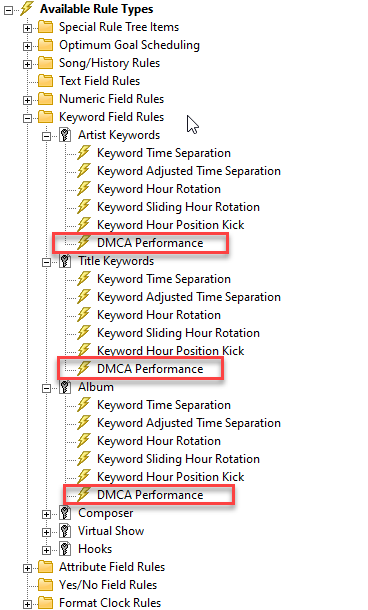MusicMaster Blog
Favored and Disallowed Patterns posted on September 23rd, 2024
by Paul Ziino
We see a lot of databases every week, and frequently, we see folks using the rules of Favored Patterns or Disallowed Patterns, but they are set up incorrectly. So today, we’ll discuss how to set those rules up and why, as well as when not to use these rules.
The Disallowed Pattern rule allows you to set a maximum of 16 patterns for a given attribute field, each up to 8 codes in sequence, that you will not tolerate. The rule is available for Attribute-Overall, Attribute-Combo, and Attribute-Multiple fields.
In the following example, we have codes 1=Ugh, 3=OK, and 5=Yay for our Mood field. We can also use code ‘?’ as a wild card. If we set a pattern of 1??1, that means we cannot have a 1 code followed by any two other codes and then another 1 code in the field. Our second disallowed pattern is 33333 which means we will not allow five Mood 3 songs in a row. And the third pattern listed of 555 prevents MusicMaster from playing three Mood 5 songs in a row. I’ve also indicated we should not include non-music items in our test of Mood – Disallowed Pattern.

The rule is tested constantly throughout the scheduling process. So wherever there is a Mood 1 song being considered, MusicMaster will look back and ahead to make sure we will not run into the disallowed pattern. Wherever there is a 3 code being considered, MusicMaster will look back and ahead to make sure we have no situation where there’d be five of that code in a row.
A common mistake we see is codes separated by commas. 1,?,?,1. This will only work if you have a comma used as a code in the field and you’re trying to prevent that code from playing in between every song. 3,3,3,3,3 will not work, nor would 5,5,5…again, unless comma is a code you’re using in the field.

Please note, only the patterns listed in the Disallowed Patterns rule will be forbidden. Any other pattern is allowed. You can only list 16 patterns max. We have seen folks use the rule multiple times with different patterns in each. The problem with this is that any pattern not listed in the first rule violates the second one. And any pattern not listed in the second will violate the first.
This all works the same way in Favored Patterns. You can create up to 16 patterns, each up to 8 codes in sequence, that MusicMaster must obey. Please note, with Favored Patterns, only those patterns listed will be tolerated. Any pattern that doesn’t show up in your list will be considered a failure. And the same goes for using a comma (or any other character) in between the codes… Don’t do it.
In the following example, we will allow a 1 code to play followed by five wildcards then another 1 code. We’ll also allow four 3s in a row followed by a 1 or four 3s followed by a 5. And we’ll allow two 5s in a row followed by a 1, or two 5s in a row followed by a 3, but no other patterns are allowed.

We mentioned that only those patterns in the Favored Pattern rule will be allowed and only those patterns in the Disallowed Pattern rule will be considered violations. As such, it would be counter-productive to use both rules in your rule tree together. This is because any pattern that passes the Favored Pattern rule will fail the Disallowed Pattern rule.
At the start of this article, I mentioned I’d explain when not to use these rules. The answer is that there is often another rule that can do the same job. For example, if you set up a Disallowed Pattern indicating 555 is not allowed, we could also turn on a rule for Mood 5, Max in Sequence of 2.

That gives you the same result as a disallowed pattern of 555.
The Disallowed Pattern of 1??1 can be accomplished with a Max in Sequence rule of 1, separated by 2.

Why do I prefer the maximum in sequence rules? Because should it be broken, we will know exactly what rule is in violation. Allow me to explain.
Let’s say I have 16 Disallowed Patterns set up in my rule and I’m editing my log, and I see a song violates the Disallowed Patterns rule. I don’t know which of the 16 patterns that song is failing. But if I use the Max in Sequence rules, the Editor will tell me exactly what rule is in violation.
By no means am I telling you not to use Disallowed Patterns or Favored Patterns rules, I’m just telling you why I prefer to use the others.
Sometimes there is no other way to get the desired result. If you always want MusicMaster to follow a certain pattern, then Favored Patterns is the way to go.

I can’t create any other rule that would give me the results of the patterns listed above.
Thinking of using a Pattern rule in your database? Give your MusicMaster Scheduling Consultant a call and they’ll help you figure out the best way to do so!
Rule Group Scheduling Trick for Near Perfect Logs posted on June 18th, 2024
by Jesus Rodriguez
In my previous life before MusicMaster, I was tasked with scheduling up to eight radio stations that were under my watch in one day. As you can imagine, that can take hours to do, especially if you have some strict rules and unscheduled positions. In this brief blog, I will share one of my favorite tricks to get the job of scheduling done quickly and accurately by using two different rule group setups. When you walk away from this, I hope you tell yourself, “Why didn’t I think of that, genius!”
I first created two rule groups, one for the Automatic Scheduler and the other for the Schedule Editor. Let’s begin with the first one, the Automatic Scheduler rule group.

Place this group in your Unbreakable section of the All-Category folder at the top of the Rule Tree. You can name it anything you like, as the name is not essential. Just make sure it’s something you can easily remember. The key settings here are the ‘Availability’ dropdown, which should be set to ‘Rules are only available in the Automatic Scheduler’ and the ‘Group Mode’ in the upper right, which should be set to ‘Test rules as if they are not in a rule group.’
In this Rule Group, place all your most restrictive rules that would be perfect in a perfect world. If you had enough music, genres, artists, tempo, etc., this rule would create your perfect radio station for the entire day. However, yes, I am hearing you. “Wouldn’t this create some unscheduled positions?” Yes, so now let’s move on to the second Rule Group.

Like the first Rule Group, you can give it any description you like. The name does not matter. Make it something familiar to you. The most critical parts are the dropdown under ‘Availability’ set to ‘Rules are only available in the Schedule Editor’. Also, like with the first, put your Group Mode on the upper right to ‘Test rules as if they are not in a rule group’.
Copy the rules from the first Rule Group and paste them into the second one. You can place this group in your Unbreakable or Breakable folder in the all-category section. I personally like mine in my Breakable section for this group. Now, go through your rules, and relax those you usually break when manually filling in unscheduled positions. For instance, if your rule is set to not play more than two rock songs in a row, but you occasionally allow three in a row to fill in the unscheduled position, set it up that way here. This way, the next step does it for you, eliminating the need for manual adjustments. This applies to any other rules you tend to look past or relax in your decision-making when you have to fill unscheduled positions. Think of what is ok and not that big of a deal for your station’s listening experience; hits are hits!
Now that these two Rule Groups are ready, run your Automatic Scheduler by going to Dataset, Schedule, and Automatic Scheduler. You will end up with unscheduled positions because of the stricter rules of your perfect radio station scenario in Rule Group One. When the Schedule Editor is opened after your Automatic Scheduling is complete, hide everything but your unscheduled music elements from the log by going to the Show/Hide Elements tab.

This will open the following window, and you can hide these items temporarily by unselecting them.

Your log should look something like this with all your unscheduled music elements. To turn all those positions blue, click on the top left corner box, as shown in the image below.

Are you ready for the magic? Press Shift + F9. This will now fill in all of your unscheduled positions with the more relaxed rule settings you created the same way you would select your songs manually for unscheduled positions, should you decide to break your rules.
Now, I will get my occasional third rock song in a row, which is not the end of the world for me, and any other rules I felt were worth relaxing. On the plus side, I only have a handful of unscheduled songs, an almost 100% perfect log based on my ideal radio station rules. It also allows for filling in unscheduled positions in seconds rather than taking much longer to go through each position.

I highly recommend restoring all the hidden elements and reviewing your log for any adjustments you may want to make.

This trick is helpful and saves time while getting you closer to a perfect log in minutes. If you need any assistance, please contact your support representative at MusicMaster.
Which Rules are a Top Priority? posted on February 27th, 2024
By Chris Hulsether
What rules are the most important? Which ones do you want to pass first? Why does it matter? That’s what we are talking about here.
First, let’s break down the Rule Tree. You will have folders for Breakable and Unbreakable Rules.
The first folder you see in the tree is for All Categories, and it includes Breakable and Unbreakable folders. These rules apply to all categories. So, if you have a gold-based format and you want to apply Artist Keyword Time Separation to every song, drag the rule over from available rule types and place it in one of the folders. This will apply to All Categories, and you won’t have to put the same rule in each category.
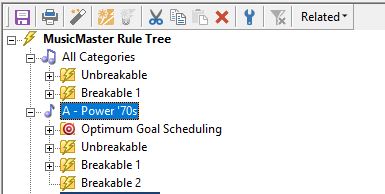
But what if you want the rule to apply to MOST categories instead of ALL categories? Right click on All Categories and select Rule Tree Properties. That’s where you can select which categories should be bypassed. Meaning they will not be subject to rules in All categories.


You can then set rules for those categories inside each individual category’s folder where they can play by different rules. Typically, Imaging categories or small high rotating current music categories would have different rules than the rest of your categories.
You can also set which rules should have highest priority. By default, the All-Categories rules get tested first and then the individual categories get tested. But in the Rule Tree properties, you can switch it so that Individual categories are on top, and the Individual category rules will be tested first. Once an Unbreakable rule fails in All Categories, the Automatic scheduler will not bother to test against the others. So, whatever rules you list first are most important. You should have your rules listed in order of importance. For example, if you list a Sound code rule first and a song fails that rule, it will keep it from scheduling, but if Artist Keyword Time Separation is more important you may want the song to clear that rule before testing other rules that may not be as important.
Of course, MusicMaster will stop testing once it fails an Unbreakable Rule, and that song will be skipped. But it will also stop when it fails the first Breakable Rule. That song may still be in the running, but MusicMaster will move onto checking the next song to see if it performs better. There’s no point in worrying about lower priority rules if a higher priority one fails.
To see the order in which your Rules are tested, you can bring up the Rule List. Right-click on the category in your Rule tree and select View Category Rule list. This will show you the order in which the rules will be tested.
Note that you can also create more Breakable folders if you need. For example, right-click on Breakable 1 and choose Add Breakable Rule Folder, and a Breakable 2 will be created.
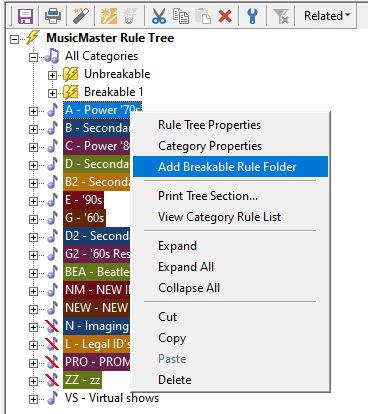
You may ask: Why would you want to have multiple Breakable rule folders? It has to do with the way the rules are all merged together when testing. Remember, rules are tested in order of importance. So the rules in each Breakable folder on your rule tree will merge with the rules in their corresponding numbered folder. This keeps all your higher priority rules above your lower priority rules, no matter which category folder they came from.


Prioritizing your rules can make it easier for the Automatic Scheduler to find the best songs possible for you and can reduce the number of unscheduled songs you may get. If you have any questions, talk to your Music Scheduling Consultant.
Max Plays Per Day posted on January 29th, 2024
By Jesus Rodriguez
We often get calls where the perfect song with no rule violations plays way too many times in the day because it is the perfect item for any scenario in your station’s music log. The question that comes up is if there is a way to prevent a song form playing so many times, and the first thing most clients think of is minimum rest. That can help, but once that rest is accomplished, guess which song will likely be able to schedule right away?
Instead, you can use Max Plays Per Day. I realize that Max Plays Per Day is not a rule that many know exists, so I decided to write a blog on that topic, and it is a very easy one at that too.
The Max Plays Per Day Rule is located here:
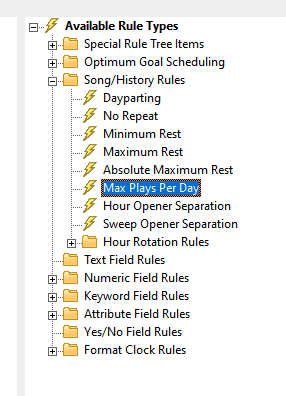
Drag and drop it into your desired category or rule section.
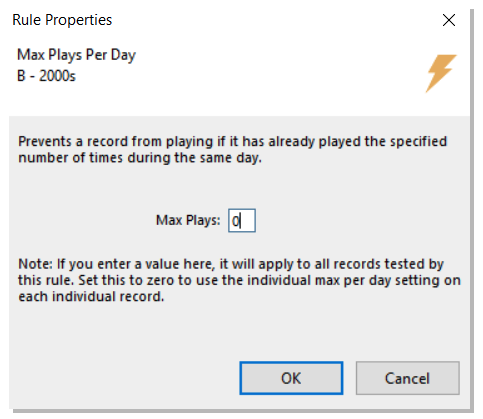
You can then place a number representing the quantity of plays that any given song will be allowed to play from within that category. However, if you place a zero there, you can control the quantity of plays each song will be able to play individually on a song-by-song basis. Placing a zero will allow you to have a different number of maximum plays per day per song so they are not all the same, as they would be if you were to place a number here within the rule tree.
If you decide to place a zero to give each song a different max number of plays per day, there is an additional step to assign the play count per day to each song. You will have to open your category in the Library and include the Max Per Day field in your library grid view so you may type in the amount of plays you prefer for each song. Remember, you still have to have the rule in the rule tree in order for this to work, but it must be set to zero.

Once the field is added to your view you may begin to place the desired number of plays per each song. If left blank that item will continue to rotate as it always has in the past with no restrictions.

We hope this will help you with controlling your number of plays per day. If you have any questions on this topic, please contact our team of music scheduling support representatives.
Maximum Rest vs Absolute Maximum Rest posted on January 22nd, 2024
by Paul Ziino
There are lots of rules available in your Rule Tree. I see these two used frequently, but they are often misunderstood.

First, what does Maximum Rest do? When you place Max Rest in your active Rule Tree, it acts as a turnoff point. Once the time has been met as set in your Max Rest rule, any rules that come after it are turned off, thus making the song a priority for scheduling. Here’s my rule list for category H-Hot Recurrents.

Max Rest is set to 1d 13:00. Once a song has rested longer than 1d 13:00, Maximum Rest will turn off the rules that follow. Basically, once a song has rested 1d 13:01, we no longer will test the Tempo rules in this example. You will see this in the Schedule Editor represented by rules that are listed in black—black rules are not being tested. (The two rule groups that appear in black do so because they have time restrictions and are not being tested at this point in the schedule.)

Notice I said Maximum Rest turns off the rules that come after it. Maximum Rest does not turn off Optimum Scheduling Goals. So if the Goals are in place, they will still play a part in the automatic scheduling process.
But there is another rule option available if you really want to ensure the song plays, no matter what. If Absolute Maximum Rest is exceeded, the song is immediately scheduled right then and there without regard to any existing rule failures or Optimum Goals.

To summarize, Maximum Rest will turn off the rules that come after it, while Absolute Maximum Rest turns off the rules and the goals that come after it in the rule hierarchy.
As always, if you have questions on this or any other MusicMaster related topic, don’t hesitate to reach out to our support team. We’re happy to assist!
Rule Tree Filters posted on April 26th, 2023
What Rules are we using and where are they?
by Chris Hulsether
What if I told you, you could save time and find out what rules you are using and where they are in your Rule Tree?
Maybe you just took over a database and you have no idea what the person who had it before you were doing. You see all these available rules and you’re wondering “What are we doing?” and “Where are the rules set up in my Rule Tree?” Maybe you see a rule that you want to use, but you are not sure if has already been set up. Maybe you have a lot of categories and you don’t want to go through each category one by one to see what rules they have. Or maybe you could be getting unscheduled events in your log because of a rule you didn’t know you had, and you want to find where it’s being used so you can adjust it or get rid of it.
To help see these things easier, you can Filter your Rule Tree to identify everywhere a specific rule is being used. It’s a quick and easy way to see what rules you are using and which ones you are not.
First, go to your Rule Tree using the Dataset/Rule Tree or clicking the toolbar icon.

On the left is your Rule Tree with all the rules you are using. On the right is the list of all the available rules you can use.

To expand your rule tree folders or the available rule folders, click on the little square box with the plus sign in it.
You can also right click on the Category and select Expand or Collapse to open or close it. If you right click on the words in bold MusicMaster Rule Tree you can Expand or Collapse all the categories at once. The same can be done on Available Rule Types.
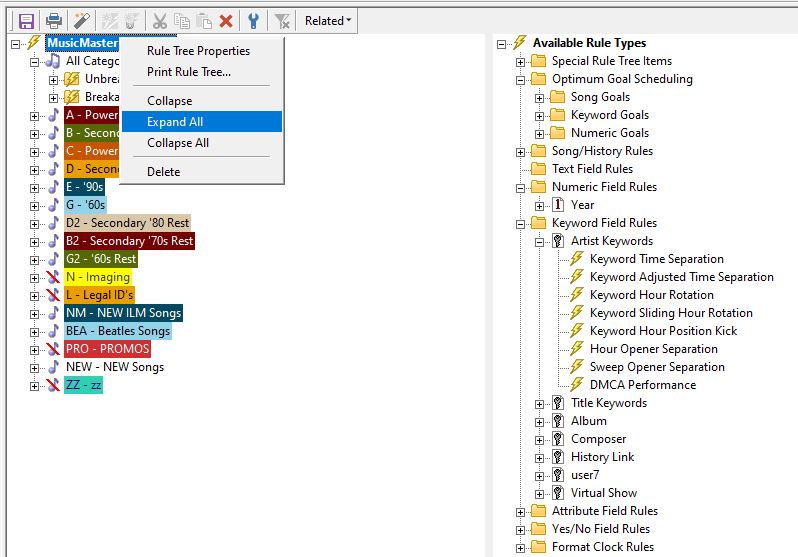
In your Rule Tree you will see the Breakable and Unbreakable folders. Unbreakable means MusicMaster will not violate the rules in that folder when you auto schedule or when the replacement window is choosing the “perfect” songs to choose from. Breakable means the rules inside the folder will attempt to be followed, but if the software cannot find another song to schedule that passes those rules, it will break the rule as a last resort.
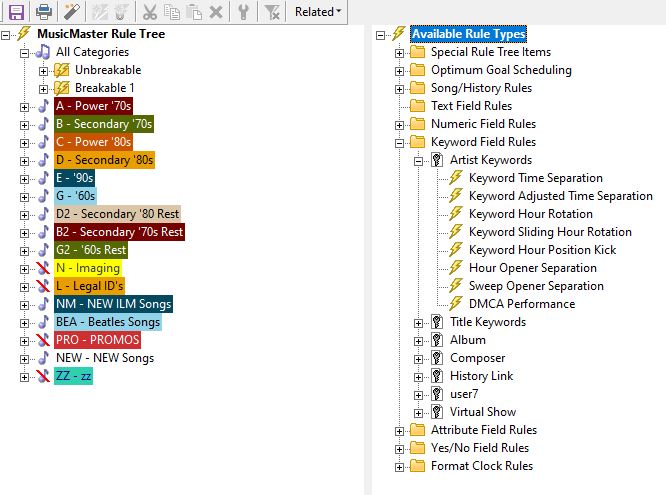
To Filter the Rule Tree
Right click on any available rule on the right.

Once selected, the left column will show you everywhere the rule is being used. If it’s not being used, the left side will be blank.

To clear the Filter, look for the icon of the filter with an x on it.

MusicMaster is all about saving time and working as quickly as possible. Ask your Music Scheduling Consultant for assistance if needed.
Almost Perfect – Setting the Order for Your Rules posted on February 21st, 2022
Almost Perfect – Setting the Order For Your Rules
By Brian Wheeler
We’re dipping into the mailbag this time around. I had a client ask me, ‘should the rules in my rule tree be in any specific order?’ My answer is they don’t HAVE to be, but there are benefits to arranging your rules strategically.
For example, let’s say you’ve got a series of unbreakable rules enforced, and the first rule in the list is a stringent one…let’s say it’s Artist Separation. If MusicMaster tests a song for Artist Separation and the song in question breaks this unbreakable rule first, will MusicMaster keep testing or just move on? The answer is, MusicMaster will stop testing the remaining unbreakable rules and will move on to the next song in the search depth because this song can no longer be considered for the position. You’ve just saved your automatic scheduler the time and effort of testing the other rules. Of course, I have no way of quantifying how much time that saved, but efficiency is a good thing, right? My recommendation is to get those rules in an order that eliminates the most obvious songs right away.
DMCA Rules Made Easy in MusicMaster! posted on December 27th, 2021
By Laurie Knapp
If you have a streaming station, you’re likely very familiar with DMCA, or the Digital Millennium Copyright Act. The boring backstory is that these are a set of US copyright laws that were enacted in 1998 to implement treaties of the World Intellectual Property Organization to prevent the illegal copying of music. In a nutshell, the DMCA sets rules for what can be legally broadcast on internet radio. You can find a handy breakdown of all the regulations here (https://help.live365.com/support/solutions/articles/43000533112-what-is-dmca-)
In addition to rules limiting things like rebroadcasts and program announcements, the DMCA also has guidelines for how often albums and artists can play. That’s where MusicMaster comes in!
Specifically, the rules state that within a three-hour time period:
- You must not play more than three different songs from the same album, with no more than two of such songs played consecutively.
- You must not play more than four different songs from the same compilation/set, with no more than three of such songs played consecutively.
- You must not play more than four different songs by the same featured artist, with no more than three of such songs played consecutively.
If you have a lot of the same artist or album in rotation, or a lot of music sourced from compilations, this might actually present a challenge for you. Sure, you could set time separation rules on your artists and albums, but can you be sure you’re doing enough?
Fortunately, there’s a special MusicMaster rule that makes it easy to keep track of whether you’re meeting these regulations. It’s called DMCA Performance. You can find it in your rule tree if you look under your Keyword Field or Text Field rules, where you have your artist, title or album fields.
For the sake of meeting DMCA compliance, you’d want to add one DMCA Performance rule for your album field and one for your artist field. You might want to apply it to your All Categories folder, or to a Rule Group that contains just your music categories.
You can see from the rule settings that it addresses both DMCA requirements at once: the maximum quota and the maximum in sequence that can be played within three hours.
For Album, you’d want to set the max quota to 3 and the max in sequence to 2.
For Artist, you’d want to set the max quota to 4 and the max in sequence to 3.
What about compilations?
Chances are, your compilation album titles are stored in the same field as your single-artist albums, so the more restrictive DMCA rule you set for your Album field will apply to them as well, even though technically you could have gotten away with one more play.
If you really want to squeeze that extra play out of your compilation albums, you might consider adding a separate “Compilation Album” keyword field where you store your compilation album titles, instead of in your main album field. You could then apply a separate DMCA rule to that field with a max quota of 4 and a max in sequence of 3.
Keep in mind, if you decide to do this, you may need to create a third album field that contains ALL your album titles together. This would be the single field you reference when sending metadata to your streaming service for display, or for running required reports like Sound Exchange.
While setting up your DMCA rules, there are also some other options you can configure. For example, you can choose to ignore non-music elements so they aren’t included in the count. That way if you applied these rules to your All Categories folder, you wouldn’t end up with an unnecessary rule violation for playing more than four pieces of imaging from the same source.
You also can choose a “rule cutoff” – or the point at which you want to stop or reset the counter. These Rule Cutoffs are more commonly used with other rules, such as Segue Protection or Max in Sequence. However, they are included on the DMCA rule settings in case you need to use them.
The options include:
- Hour Marker: Cuts off or resets the rule whenever the Scheduler encounters an Hour marker.
- Sweep Marker: A sweep marker is designated using a LogNote position in your clock. A single sweep can’t be more than three hours long. If you choose this Rule Cutoff option, the rule will only count songs that play between two Sweep markers and will reset once it passes into the next sweep. So, for example, if you happened to schedule two songs from the same album on either side of a sweep marker, your rule wouldn’t count this as two in a row.
- Break Element: A break element is anything that has more than a zero runtime but is not scheduled from a category, like Stopsets, Lognotes and Traffic positions. So, for example, you might only want a certain rule to count songs that fall between two traffic breaks in the hour.
- Record Type: You can specify Music or Non-Music here. For example, you may want a rule to apply across a sequence of songs, but reset once a piece of imaging plays.
For the purposes of meeting DMCA guidelines, you’ll want to make sure you capture any potential violations within a three-hour period, so be cautious when using any of these Rule Cutoffs that you aren’t inadvertently resetting the count too soon.
One more tip: Another DMCA rule requires that you display the title of the song, title of the album and the featured recording artist. So, make sure you have that information filled into your MusicMaster library! Blank values may be read by the tracking service as “Unknown….” and you certainly don’t want to get flagged for playing three back-to-back songs from an album titled “Unknown Album”!
If you have any questions about the setup in MusicMaster, do not hesitate to contact your MusicMaster Scheduling Consultant.
Got the Slow Morning Blues? posted on August 9th, 2021
Got The Slow Morning Blues?
By Dave Tyler
I have been a Morning Man most of my 36+ year radio career and yes I was that guy going into my PD/MDs office saying “Dude please schedule something with tempo in the mornings…..it’s a dirge-fest in here!”. I think listeners feel the same way for the most part. Please don’t misunderstand me I LOVE ballads! I’m a Country guy and when Garth had “The Dance” out listeners demanded it and we sure played the wheels off it! However, if overall you really just want medium to fast tempos tunes to play there is a very easy way to do it in MusicMaster.
It’s going to require a Rule Group but don’t fret this process can all be done in literally five minutes assuming your songs are already coded for Tempo. Let’s get started. First, we need to make a rule group. Open your Rule Tree and under Special Rule Tree items you will find Rule Group. Drag it into your All Category Unbreakable folder like the pic below.
The Rule Group box will pop up and there are several things to do in here. 1) In the Description box enter the name of the Rule Group. 2) Click Create/Modify button. 3) Place “X”s in the hours for your morning show. 4) Click the Save Icon, this will allow you to name this particular restriction. In my example it is “NoSlow Morning”. TIP: Adding the time frame into the name will remind you what it’s for so you don’t inadvertently change it. 5) Click Apply. This will bring you back to the original screen.
Now 1) Click on the “Categories” button and 2) place a check mark in each of the Music categories you want affected by this rule group then 3) Click OK. 4) Now click the button for “Match”. This means the categories you selected will have the NoSlow applied to them during this time period. 5) Finally bubble the “Restricted” and then 6) OK.
Guess what??? We’re almost done! Open your Attribute Field Rules and drag your 1-Slow & 2-Slow/Medium tempo “Not Allowed” rules into this folder. Save your Rule Tree and you’re done. No more Slow Morning Blues for you!!!!
If you have any questions just contact your dedicated Music Scheduling Consultant.
Music Scheduling Therapy posted on June 28th, 2021
Music Scheduling Therapy
By Chris Malone
If you have had the privilege of sitting in a therapy session, you are aware of the benefits of having someone look at your life’s configuration and help recommend ways to get back on track. Did you know in MusicMaster, you have a built-in music scheduling therapist at your disposal too? One of the overlooked features in your Rule Tree is the Rule Wizard that gives you a list of recommendations to make to your rule tree based upon your last scheduling session.
This feature helps determine rotations miscalculations and rules that may be off-base due to the lack of available inventory in your actively scheduled music and non-music categories. The Rule Wizard can pinpoint problems with rest settings, hour rotation rules, and indicate how your attribute rules affected the scheduling session. If you notice an abundance of unscheduled positions in your most recent scheduling session, you may want to review this list and see what your MusicMaster therapist recommends.
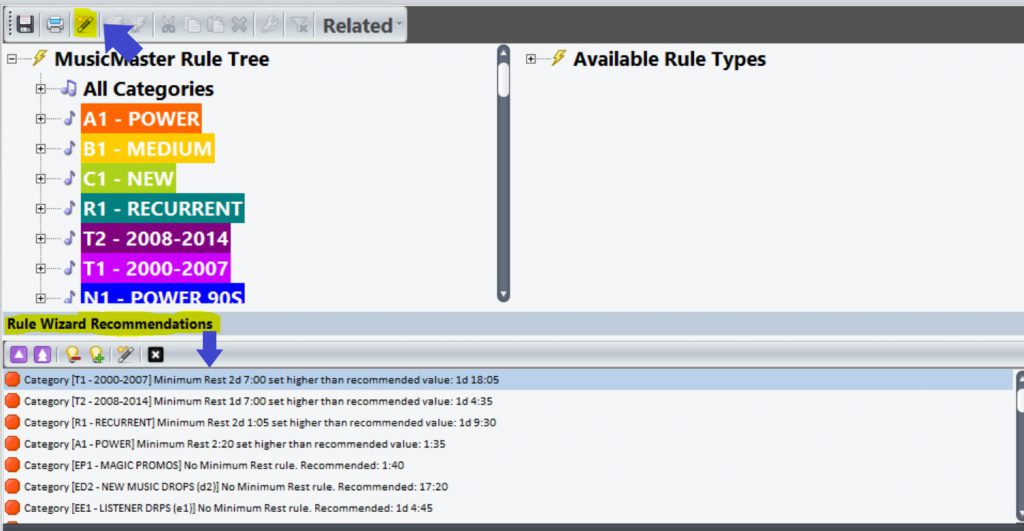 Additionally, you can benefit from learning how to read your scheduler recap report (Dataset, Schedule, Recap Report). In this recap report, you can sort the pass percentage column by descending order, which shows me the rules that had lowest percentage of songs that pass any given active rule (both breakable and unbreakable). Watch out for unbreakable rules that have a low pass percentage, it indicates problems with that category’s ability to tolerate the current rule setup. Remember, this is a picture of the last scheduling session. You may wish to make some notes over the course of a week before making any changes to rules or other settings.
Additionally, you can benefit from learning how to read your scheduler recap report (Dataset, Schedule, Recap Report). In this recap report, you can sort the pass percentage column by descending order, which shows me the rules that had lowest percentage of songs that pass any given active rule (both breakable and unbreakable). Watch out for unbreakable rules that have a low pass percentage, it indicates problems with that category’s ability to tolerate the current rule setup. Remember, this is a picture of the last scheduling session. You may wish to make some notes over the course of a week before making any changes to rules or other settings. 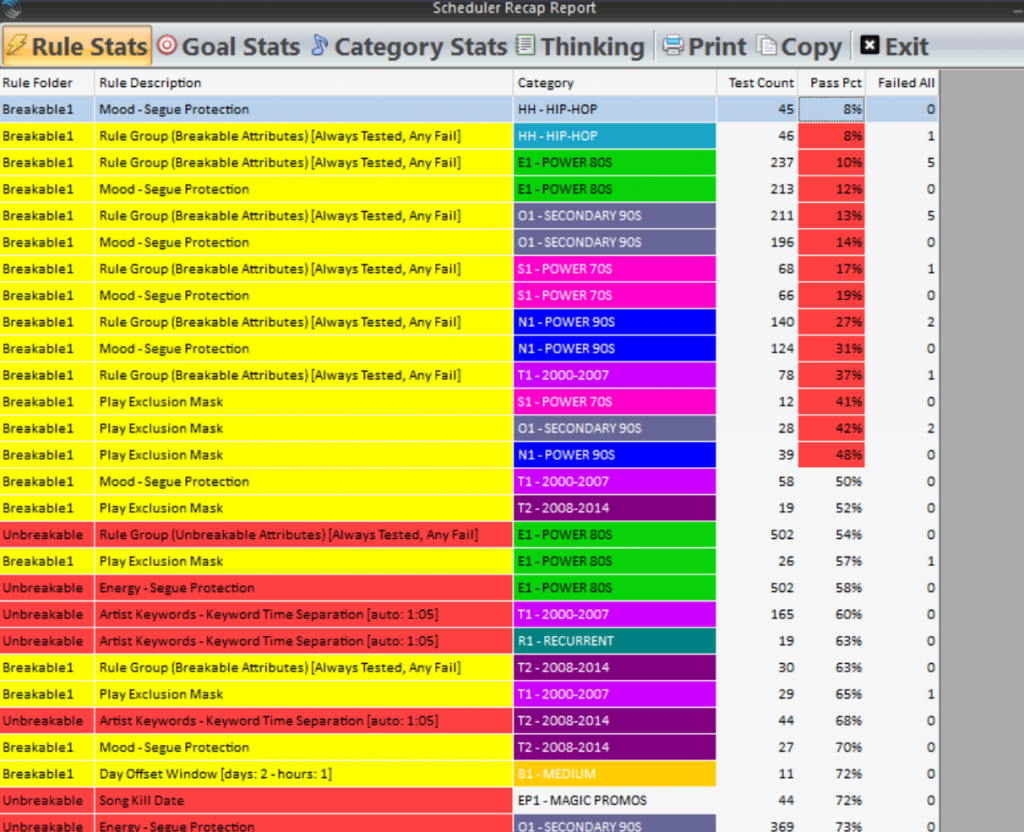
(For even more info on the Scheduler Recap report, check out this other blog article on the topic.)
You can lean on your built-in MusicMaster scheduling therapist or you can call your MusicMaster Scheduling Consultant, have a seat on the couch and tell us your problems.


